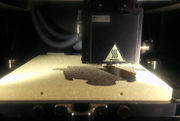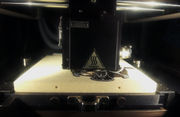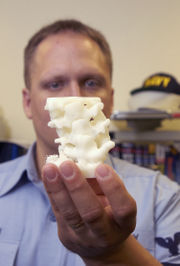- 3D Printing
-
Rapid Prototyping (deutsch schneller Prototypenbau) ist ein Verfahren zur schnellen Herstellung von Musterbauteilen ausgehend von Konstruktionsdaten.
Rapid-Prototyping-Verfahren sind somit Fertigungsverfahren, die das Ziel haben, vorhandene CAD-Daten möglichst ohne manuelle Umwege oder Formen direkt und schnell in Werkstücke umzusetzen. Die für diese Verfahrensgruppe relevante Datenschnittstelle ist das STL-Format. Die unter dem Begriff des Rapid Prototyping seit den achtziger Jahren des letzten Jahrhunderts bekannt gewordenen Verfahren sind in der Regel Urformverfahren, die das Werkstück schichtweise aus formlosem oder formneutralem Material unter Nutzung physikalischer und/oder chemischer Effekte aufbauen.
Zu den Verfahren des Rapid Prototyping gehören unter anderem folgende Verfahren:
Verfahren Werkstoffe Stereolithografie (STL oder SLA) flüssige Duromere selektives Lasersintern (SLS) Thermoplaste: Polycarbonate, Polyamide, Polyvinylchlorid und aber auch Metalle Polyamidguss Polyamide Lasergenerieren Metallpulver Fused Deposition Modeling (FDM) ABS, Polycarbonat Laminated Object Modelling (LOM) dünne Schichten aus Papier, Kunststoff, Keramik oder Aluminium 3D Printing Kalkpulver mit Epoxid-Hülle Contour Crafting (CC) Beton Multi Jet Modeling wachsartige Thermoplaste, UV-empfindliche Photopolymere PolyJet-Verfahren Space Puzzle Molding (SPM)-Verfahren Kunststoffteile aus Originalmaterial in Serienqualität In den letzten Jahren wurden die Anwendungsgebiete für diese Fertigungsverfahren, die sich am Anfang auf das Herstellen von Modellen und Prototypen - daher der Begriff Rapid Prototyping - konzentrierten, auf weitere Felder ausgedehnt. Dazu zählen:
- der Einsatz als physisches Modell: Concept Modeling,
- der Einsatz als Werkzeug: Rapid Tooling und
- der Einsatz als Fertigteil: Rapid Manufacturing.
Wegen der Breite der aktuellen Applikationen ist es derzeit angebracht, vom Einsatz generativer Fertigungsverfahren zu sprechen.
In Verbindung mit weiteren modernen Technologien wie zum Beispiel dem Reverse Engineering (Digitalisieren), dem CAD, der virtuellen Realität sowie modernen Werkzeugbauverfahren wird die Verfahrenskette innerhalb der Produktentwicklung auch als Rapid Product Development bezeichnet.
Daneben findet man auch Begriffe wie 3D-Faxen, generative Fertigungsverfahren, Solid Freeform Fabrication, Desktop Manufacturing, Layer Manufacturing Technology, Advanced Digital Manufacturing (ADM), auch E-Manufacturing usw.
Durch dieses mittlerweile stark angewachsene Einsatzspektrum von generativ gefertigter Bauteilen werden auch immer neue Anforderungen an generativ gefertigte Bauteile gestellt, die durch Folgetechnologien bei generativen Verfahren wie die Oberflächentechnik gelöst werden können. So ist es durch abtragende Verfahren wie das Sandstrahlen oder das Gleitschleifen möglich, die durch den Bauprozess bedingten Stufen einzuebnen. Auch ist es möglich, die generativ gefertigten Werkstücke zu lackieren oder zu metallisieren.
Siehe auch
Literatur
- Andreas Gebhardt: Rapid Prototyping – Werkzeuge für die schnelle Produktentstehung. 2. Auflage. Hanser Verlag, München 2000, ISBN 3-446-21242-6.
- Andreas Neef, Klaus Burmeister, Stefan Krempl: Vom Personal Computer zum Personal Fabricator. 1. Auflage. Murmann Verlag, Hamburg 2005, ISBN 3-938017-39-2.
- Wolfgang G. Trapp: Von Prototypen zur Produktion. Industriethemen-Fachberichte, München 2007.
- Westkämper Engelbert, Bohnet Jens: Oberflächenveredelung von RP-Bauteilen.. Springer, Berlin 2007, ISBN 978-3-540-69879-1.
- Bohnet Jens, Greta Bernhardt: Bessere Oberflächen auf Rapid-Prototyping Werkstücke. In: Galvanotechnik. 99, Leutze, Bad Saulgau 2008, S. 1884-1891.
Weblinks
- Forschung an Produktion und Entwicklung von Rapid Prototyping am Fraunhofer IPA
- Technology Review: 3D-Drucker für das Volk Überblicksartikel zum Stand der Technik bei Fab@Home und RepRap
- Video: Rapid-Prototyping - Interview mit Bre Pettis Rapid-Prototyping-Aktivist Bre Pettis über die Faszination des Selbermachens (Englisch)
Wikimedia Foundation.




